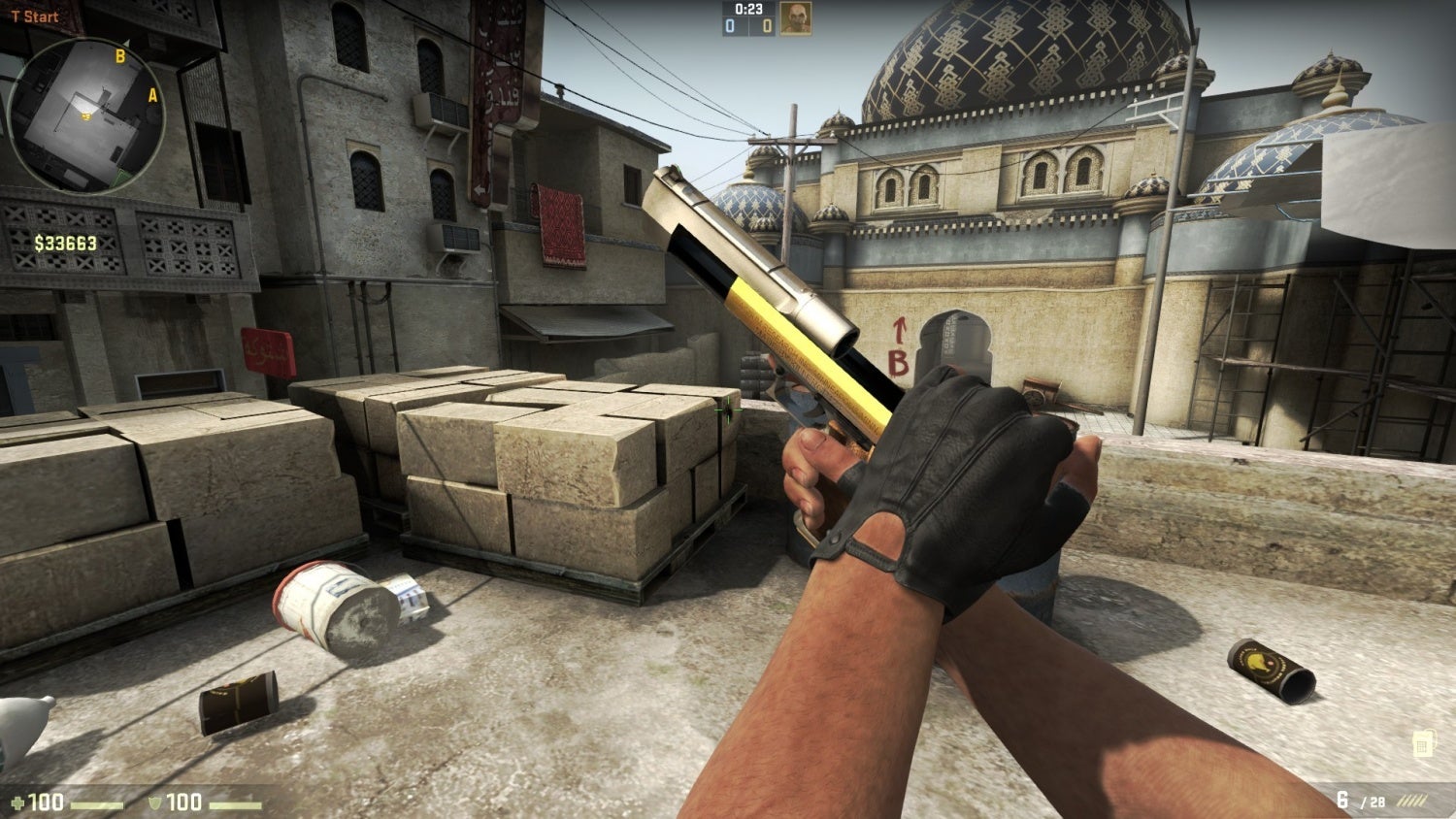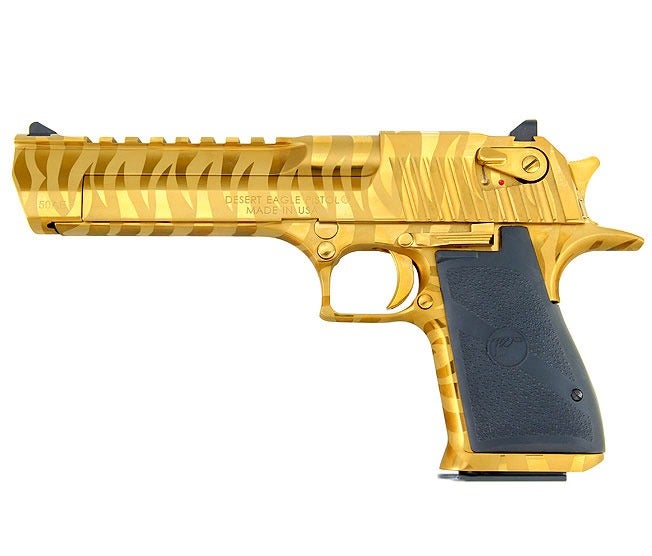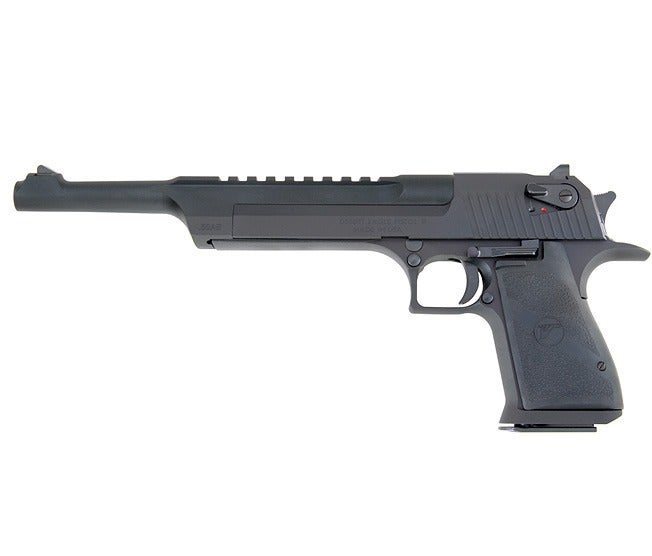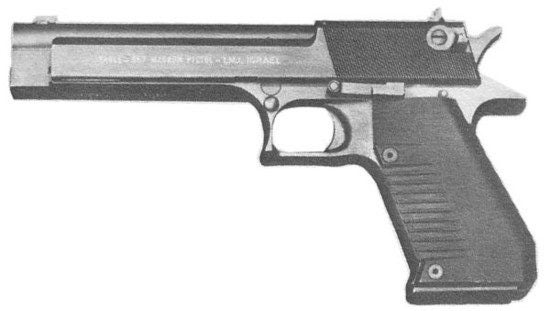The Desert Eagle XIX handgun is one of the more peculiar handguns of the late twentieth century for a variety of reasons. Most handguns introduced in the civilian and military markets are earmarked for a specific purpose, whether that be a polymer reliable Glock or a safer revolver such as the Ruger transfer bar. They’re intend to fill a void, be better than the competition, or meet a certain performance expectation. Then we have the Desert Eagle’s introduction. The large-bore handgun is advertised as a quasi-everything, depending on the market it’s going for. At once, it is a big-bore hunting handgun and novelty item; there are rumors about Special Operations use, it doubles as a target or silhouette shooting piece, it’s an experiment, and later on it gains a healthy following in movies and video games. But from a truly practical shooting perspective, it’s quite hard to justify using it in the first place. It’s too heavy, more expensive than traditional big -bore hunting revolvers, has a complicated gas-operated system, and it’s one of the only handguns to be chambered in its most popular caliber. And yet to this day, its presence is undeniable. Magnum Research is going strong, new models and configurations are coming out every year.
So there is obviously a market for Desert Eagle pistols, but why? The answer is its allure, plain and simple. It has a lot of ‘firsts’ and ‘onlys’. It’s pretty much the only relevant handgun chambered in .50 Action Express, it’s certainly the only mass produced semi-automatic .44 and .357 Magnum out there (while also being the first mass produced semi-automatic handgun to be chambered in those calibers), it holds more rounds than any similar chambered handgun of its calibers, it’s almost as recognizable as the Walther PPK through movies and video games with less than a quarter of the PPK’s production figures, and it’s one of the largest, sexiest handguns you’ll see today on the market. Despite all the disadvantages listed above, this pistol took off where other big-bore, semi-automatic handguns have been left in the dust. The Wildey pistol comes to mind because it tried to fill that void of a big-bore semi-automatic handgun, but it failed with less than 10,000 or so being produced before it was discontinued.
Conception, initial design, and production
The concept for the Desert Eagle came from a proof of concept design idea. It came about during the late 1970s when .357 magnum hunting revolvers were beginning to become very popular in the hunting community. It was also the time of reliable semi-automatic handgun experimentation. The Glock 17 entered Austrian service in 1982, Ruger’s P series was introduced in 1985, about the same time the Beretta 92F and Sig Saur P226 came into prominence. Smith & Wesson had their 39, and 59 series had also been introduced towards the end of the Vietnam War. Basically what was going on is that the development of polymers, metals, and manufacturing techniques had caught up with firearms design and the era of the revolver and 1911 style pistols was coming to an end. This also had to do with proliferation and development of rifles and submachine guns, changing the entire tactical side of things that police had to deal with and thus called for more reliable semi-automatic handguns. Realizing all this in context, it’s no surprise that the idea of a reliable semi-automatic handgun handling big-bore revolver cartridges that would attract both the revolver hunting crowd and the new semi-automatic pistol crowd became so successful
The pistol concept was put together by John Risdall and Jim Skildam, the founders of Magnum Research. Technical details and development were headed by a man named Bernard White. It is interesting to note that White isn’t mentioned at all on Magnum Research’s history page, similar to how Dave Walls invented the L96 but Malcom Cooper received much of the fanfare. It was originally built around the .357 Magnum, but later on interchangeable barrels were introduced chambered in .41 Magnum, .44 Magnum, and finally the .50 Action Express in 1991 (which was the largest claim to fame because at the time the .50 AE was the largest production handgun cartridge at the time, superseded recently by the .500 S&W). The original patent was entered in 1983, and IMI revised the design in 1985. Magnum Eagle was the original name of the handgun but as is the case with all start-up manufacturers, Magnum Research Inc. didn’t have the manufacturing capacity or funds to mass produce the pistol. Israeli Military Industries (not to be confused with the civilian break off, Israeli Weapon Industries, IWI) was subcontracted to produce the handgun while Magnum Research Inc. still retained the property rights. It was in this venture that the handgun truly took off, changing its name to “Desert Eagle” and taking on the recognizable form it still has today.
The design of the Desert Eagle isn’t actually anything spectacularly new; it’s a combination of various designs coming together. The beavertail and magazine release echo from the 1911, the gas and piston system derive from the Ruger Mini 14. The external safety and take-down lever are similar to the Beretta 92F. Operationally, gas systems in firearms are usually found on rifles and submachine guns, and not handguns. This is usually because blow back and tilt-locking barrels are more than sufficient for the cartridges that handguns are used with. The Desert Eagle, however, requires a gas operation good enough to reliably cycle the magnum calibers that it is usually chambered with. Thus the rotating bolt head found on Stoners designs was also introduced with the pistol. This use of the bolt head also lends itself to easier caliber conversions because all a user has to do is to change out the barrel and bolt head, leaving the slide and action untouched.
Company History
IMI produced the Desert Eagle until 1995, when the contract for production was shifted to Saco Defense in Saco, Maine. In 1998 production moved back to IMI, which at this point had become IWI. Beginning in 2009, production finally began with Magnum Research in Pillager, MN, where it continues to this day. The company was bought out by Kahr Arms in 2010, and control of production remains with this company. Magnum Research is still very much alive in showcasing the pistol and announcing various modifications and enhancements. A look on the current offers will show over 40 different combinations to choose from, including a titanium and gold finished variant. However, the company has expanded into various other platforms as well, such as big-bore revolvers, 1911s, .22 rifles, and a commercialized Jericho. This last platform is interesting as the company named it the “Baby Desert Eagle” despite the fact that the two pistols are completely different in design. Magnum Research used a similar advertising scheme in promoting the “Micro Desert Eagle”, claiming it shares all of the family traits with the original handgun, also despite the fact that the two have almost nothing in common.
Variants and design changes
The basic design of the Desert Eagle was changed by IMI when they took over the production of the firearm, but has since remained unchanged. The original design was called the Mark I, and then afterwards came the Mark VII. The Mark I has since been discontinued, with the Mark VII raising to prominence. The difference between the Mark I and Mark VII lies mainly in the different calibers each was chambered in, the Mark VII being chambered in .41 Magnum in addition to versions in .357 Mag, .50 AE, and .44 Mag. In addition, the Mark VII has an adjustable trigger unlike the Mark I. Today the most recent design is the Mark XIX, the difference mostly being updated manufacturing and a large variety of different finishes such as the gold or titanium mentioned earlier. A variant of the XIX has also been made to accommodate sales in the state of California, the only addition to the pistol being the incorporation of a firing pin block. This variant can be purchased with either a standard 6 inch barrel, or a lengthened 10 inch barrel for hunting purposes. There is a further variant of the 10 inch barrel in the form of a miniature scale Desert Eagle made in Russia (not related to Magnum Research). This version is for sale for several tens of thousands of dollars and is fully functional with miniature ammunition. Larry Vickers recently made it famous during a tour of some Russian manufacturers. Among all these various barrel configurations and chamberings, it’s important to note that within each variant, barrels can be exchanged to alter the length and even the caliber. Because the pistol has a separate bolt head, it can interchange matching barrels and bolt heads to accommodate different rounds. This is something truly unique about the pistol, but regardless, the handgun is usually sold with only a single barrel/bolt-head set. The pistol has gone along with many of the improvements in firearms technology, such as the addition of picatinny rails, compensators and modern manufacturing techniques. Because of the widespread popularity in entertainment, there’s even two 9mm blank firing replicas made by Bruni Combat and the Retay Eagle.

Source- Counter Strike video game. Notice the skin designer name below the company name on the handgun.
Use in entertainment media
The pistol is reported to have been featured in over 500 different movies, mostly due to its iconic image and size. But video games are where the Desert Eagle really found its niche. It is perhaps one of the only firearms to have gotten a nickname from its use in video games: the “Deagle”, a shortcut for typing “Desert Eagle” on a keyboard. One of the first games to really take advantage of the handgun is the game Counter-Strike from Source. The game used the massive size of the handgun and cartridge to good effect. Nearly every player in the game is allowed to purchase it, and it is programmed to have the hardest-hitting effects of any of the pistols in the game, even exceeding most of the submachine guns. For this reason it’s very popular among players to “buy” the gun at the beginning of a match, as a secondary or even as a primary weapon system to be used throughout the game. And although the pistol became hugely popular in Counter-Strike, it its popularity was not limited to this platform but blossomed into a number of different forms in other games because of its reputation for effectiveness.
 Your Privacy Choices
Your Privacy Choices



